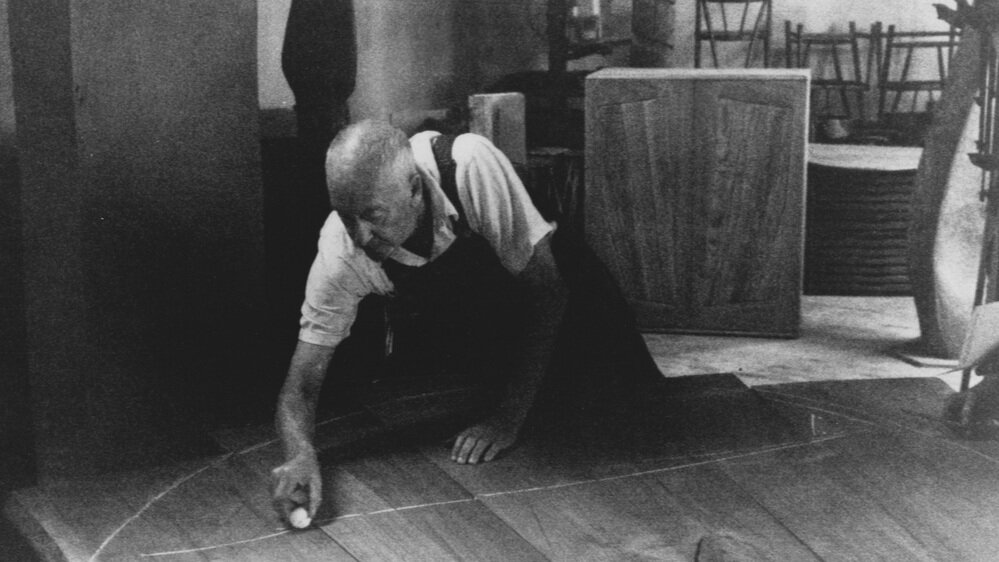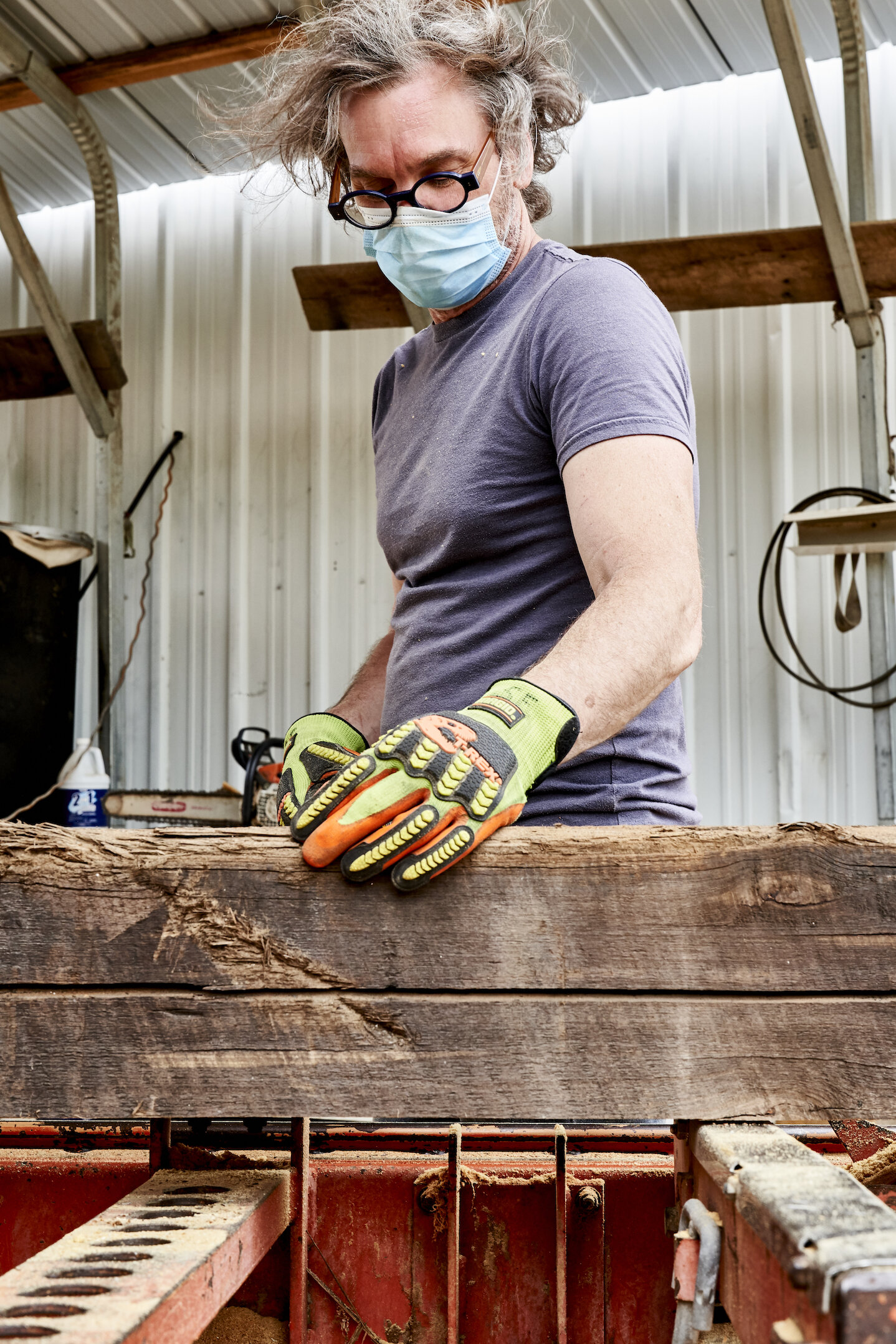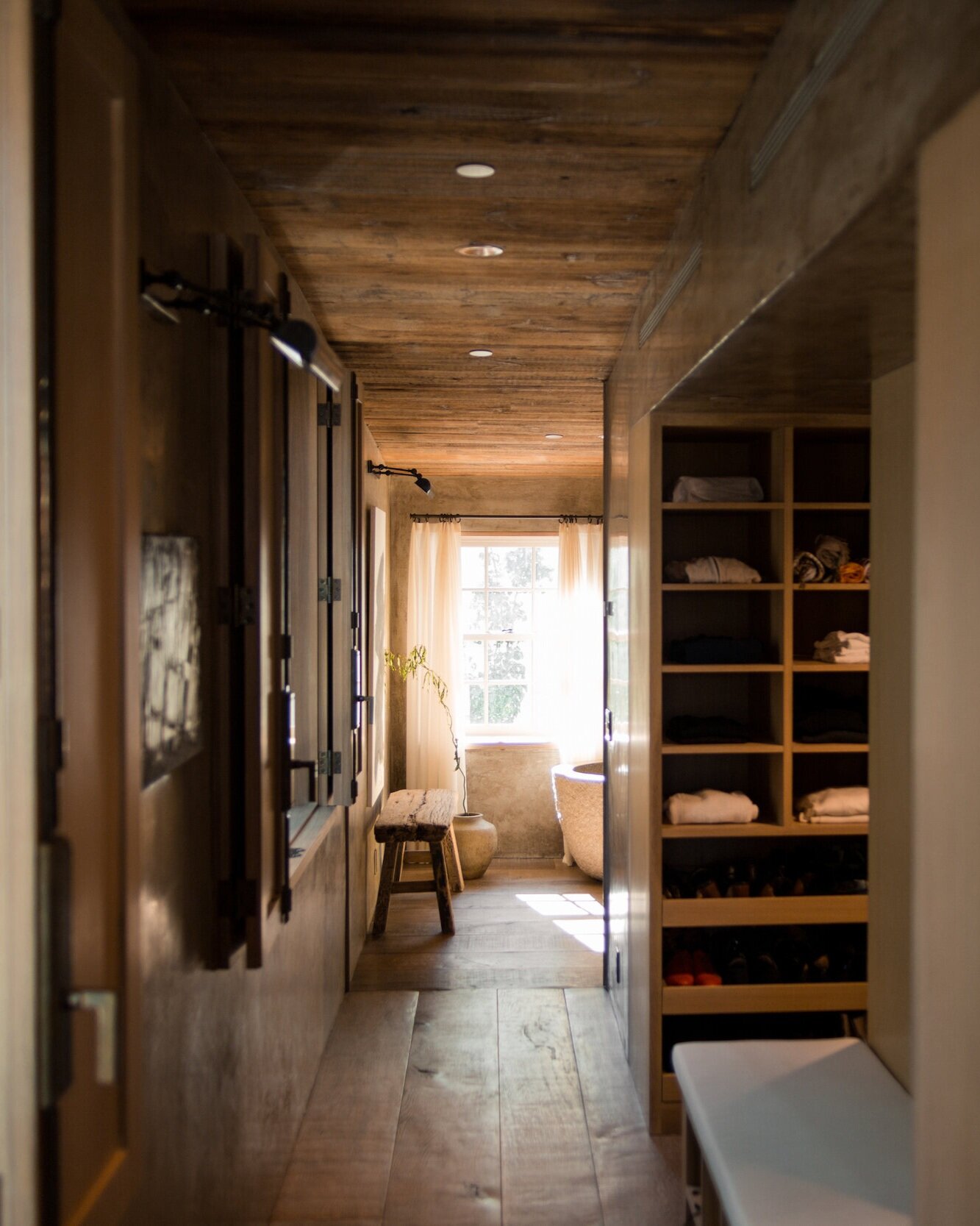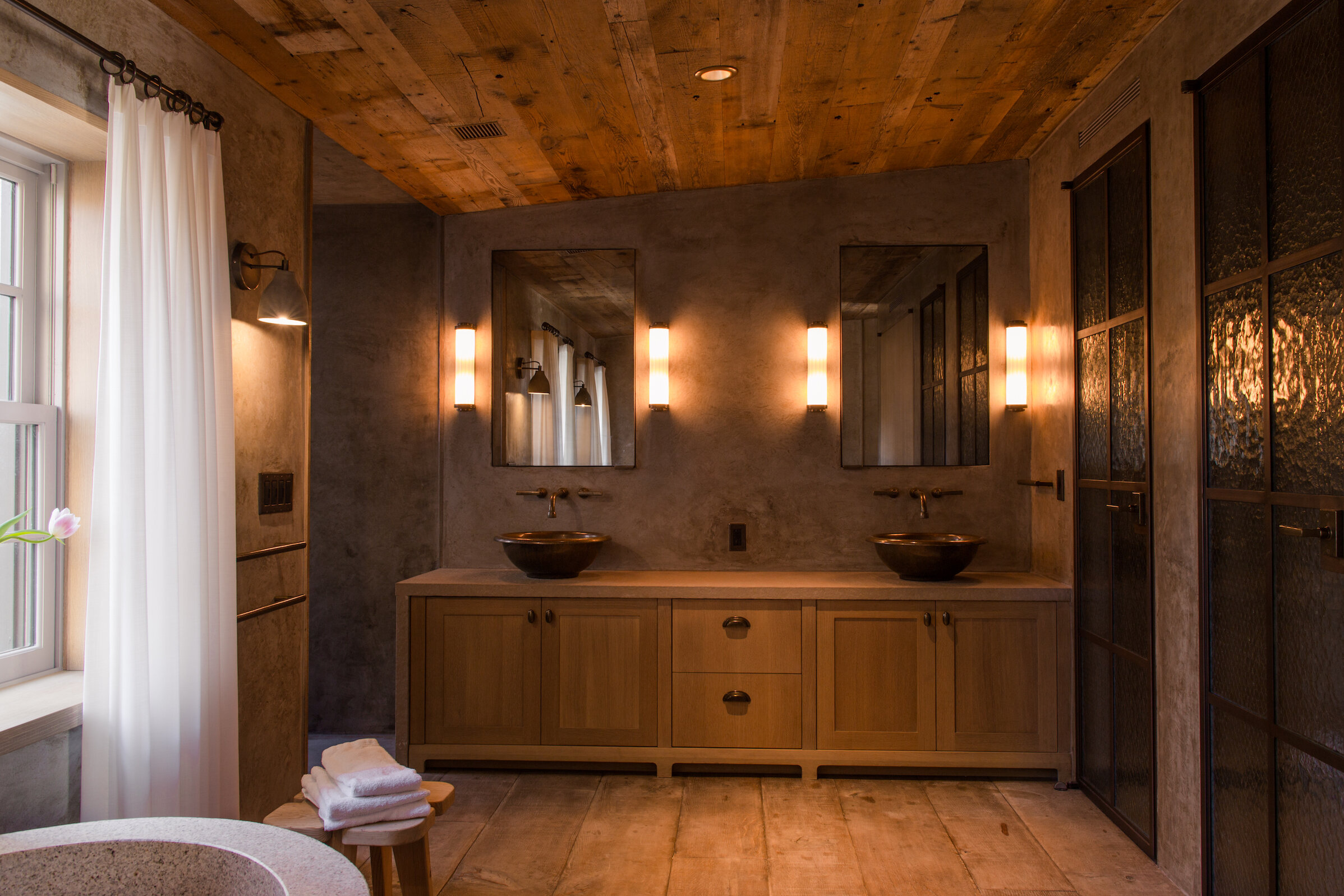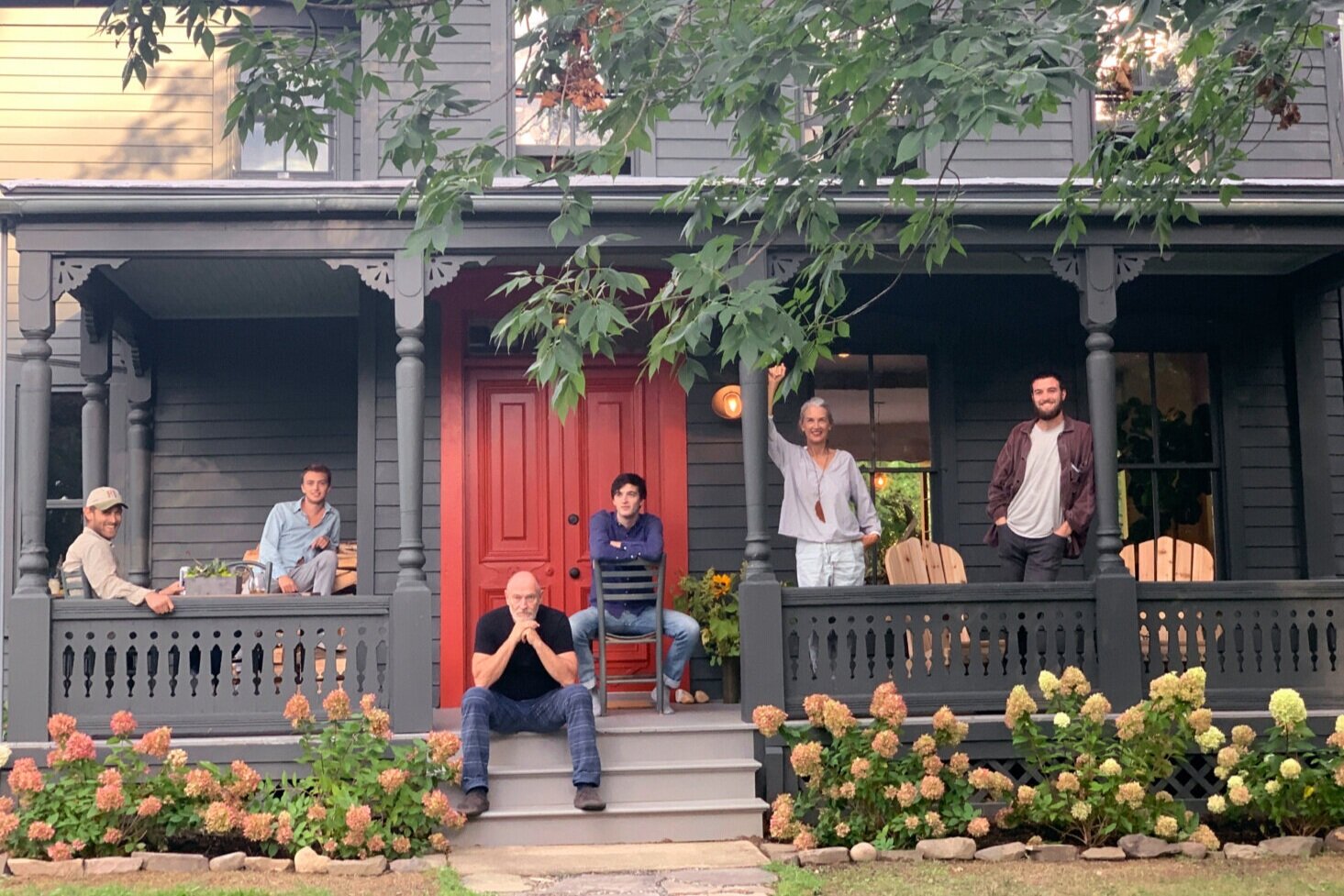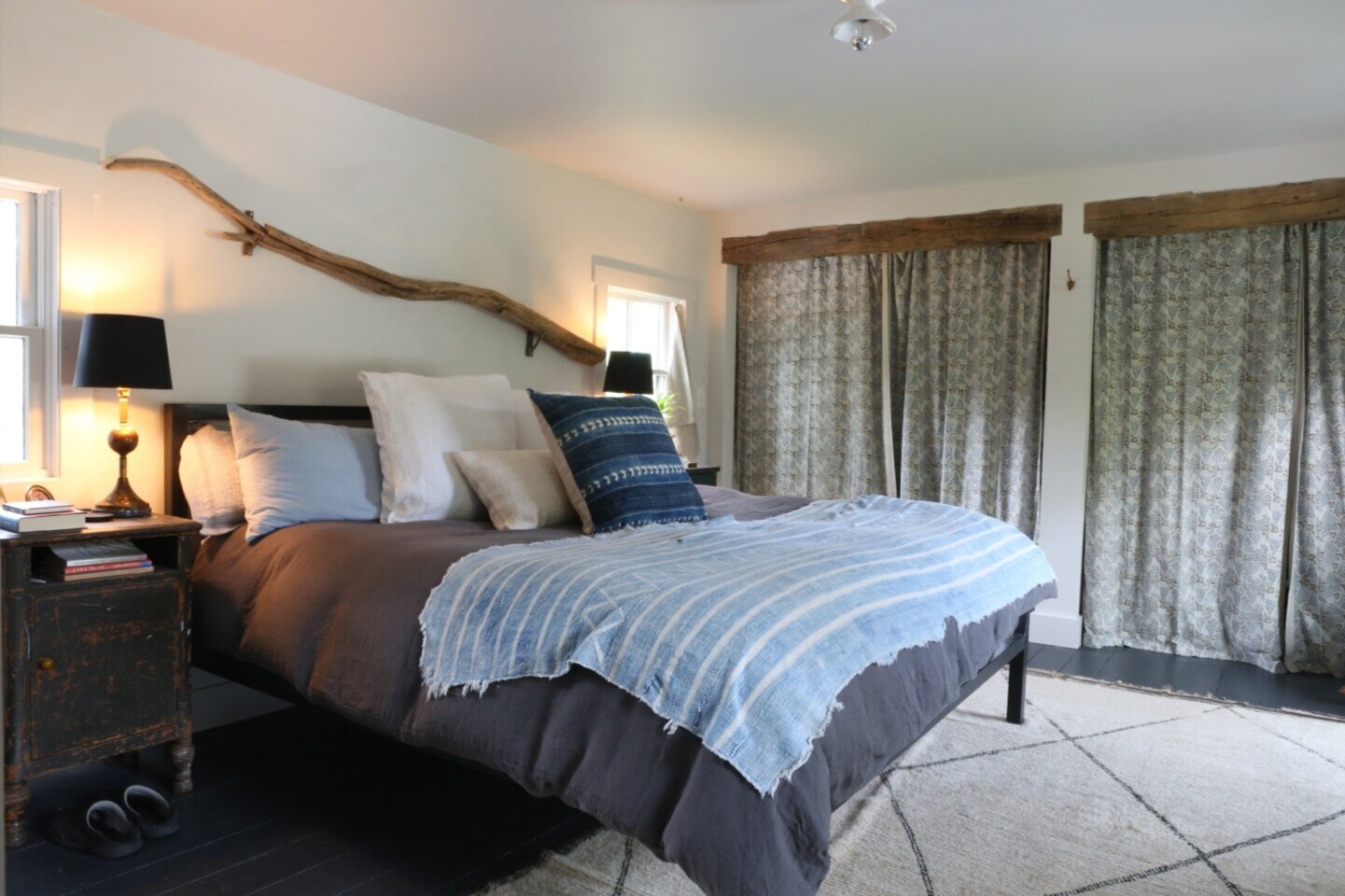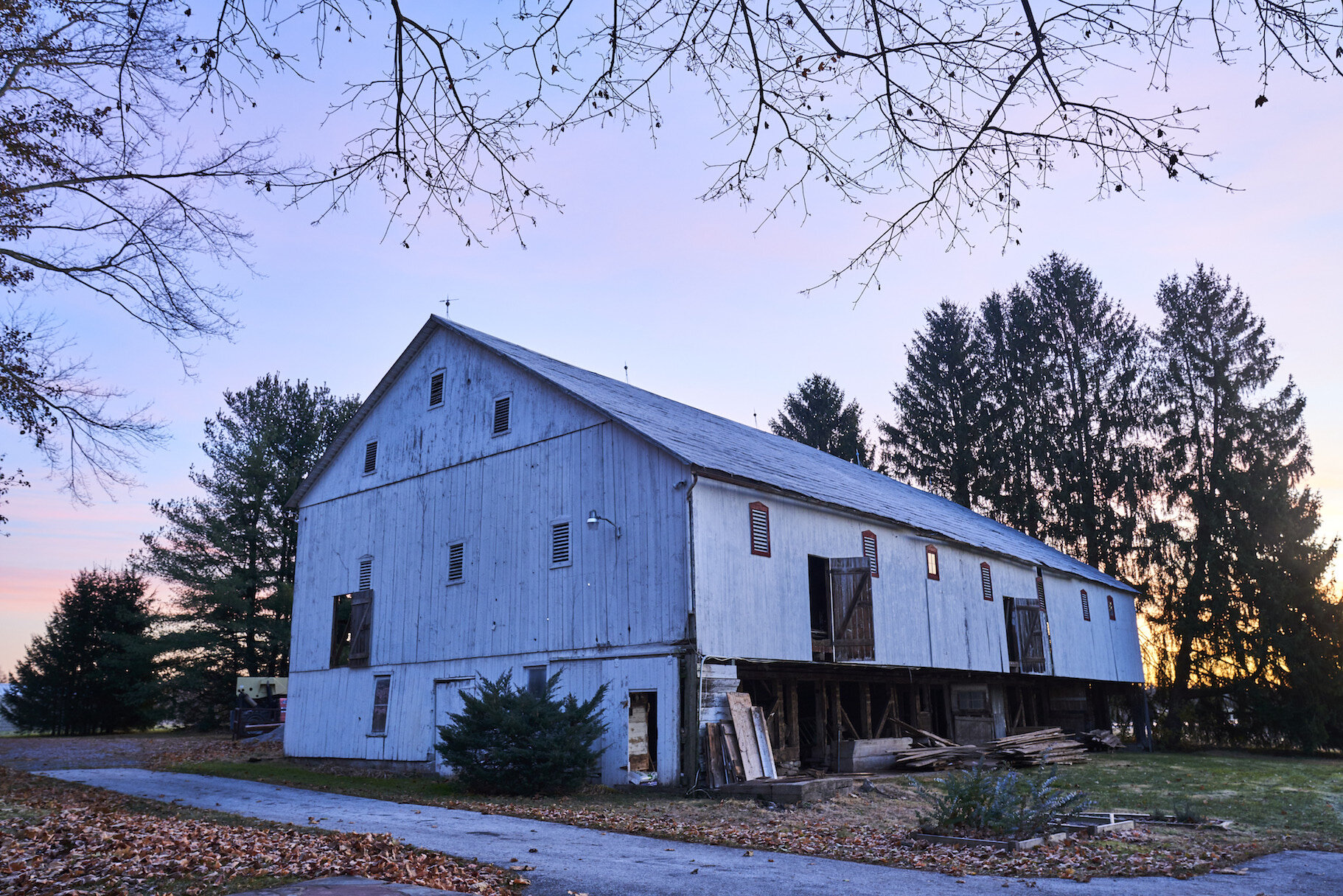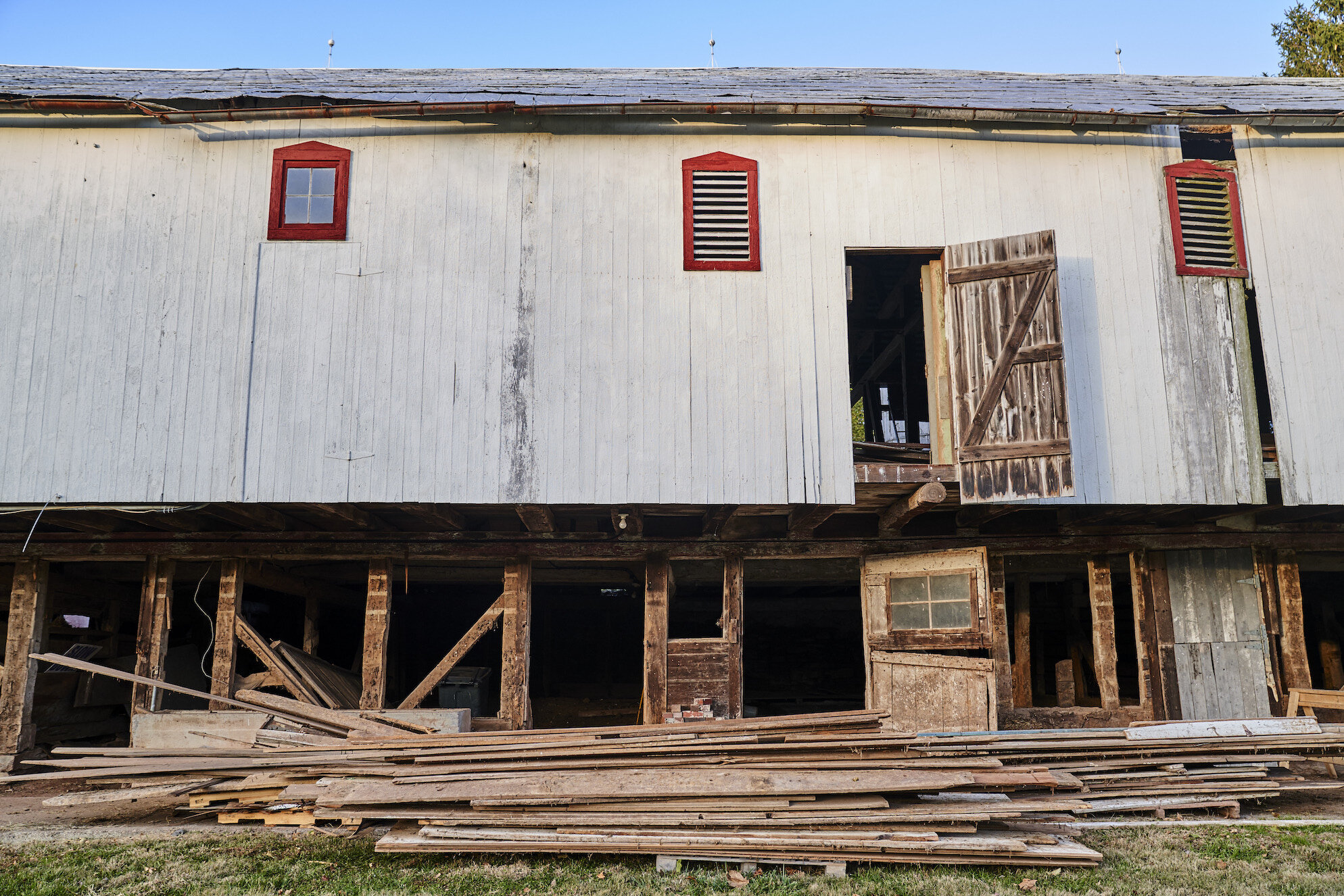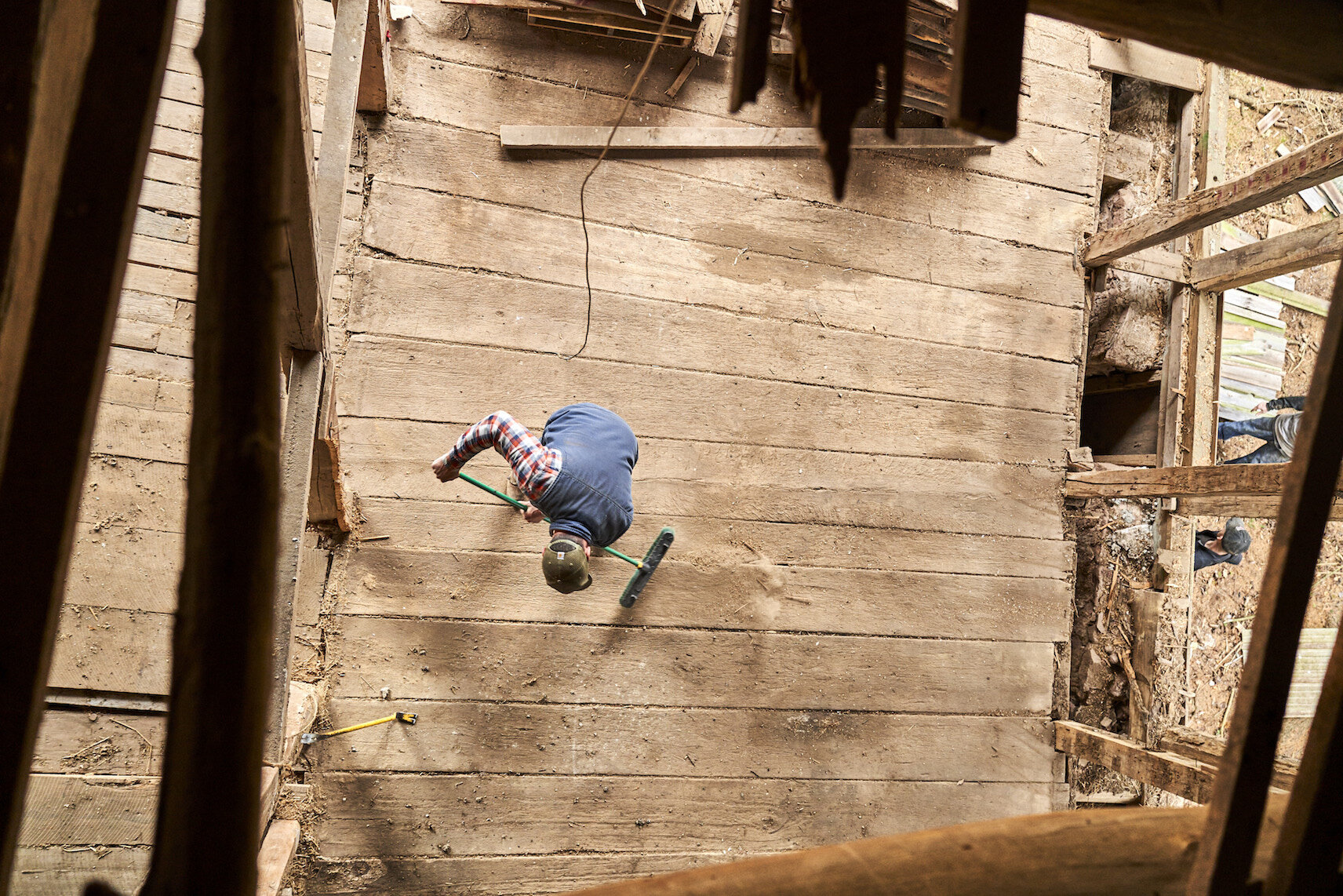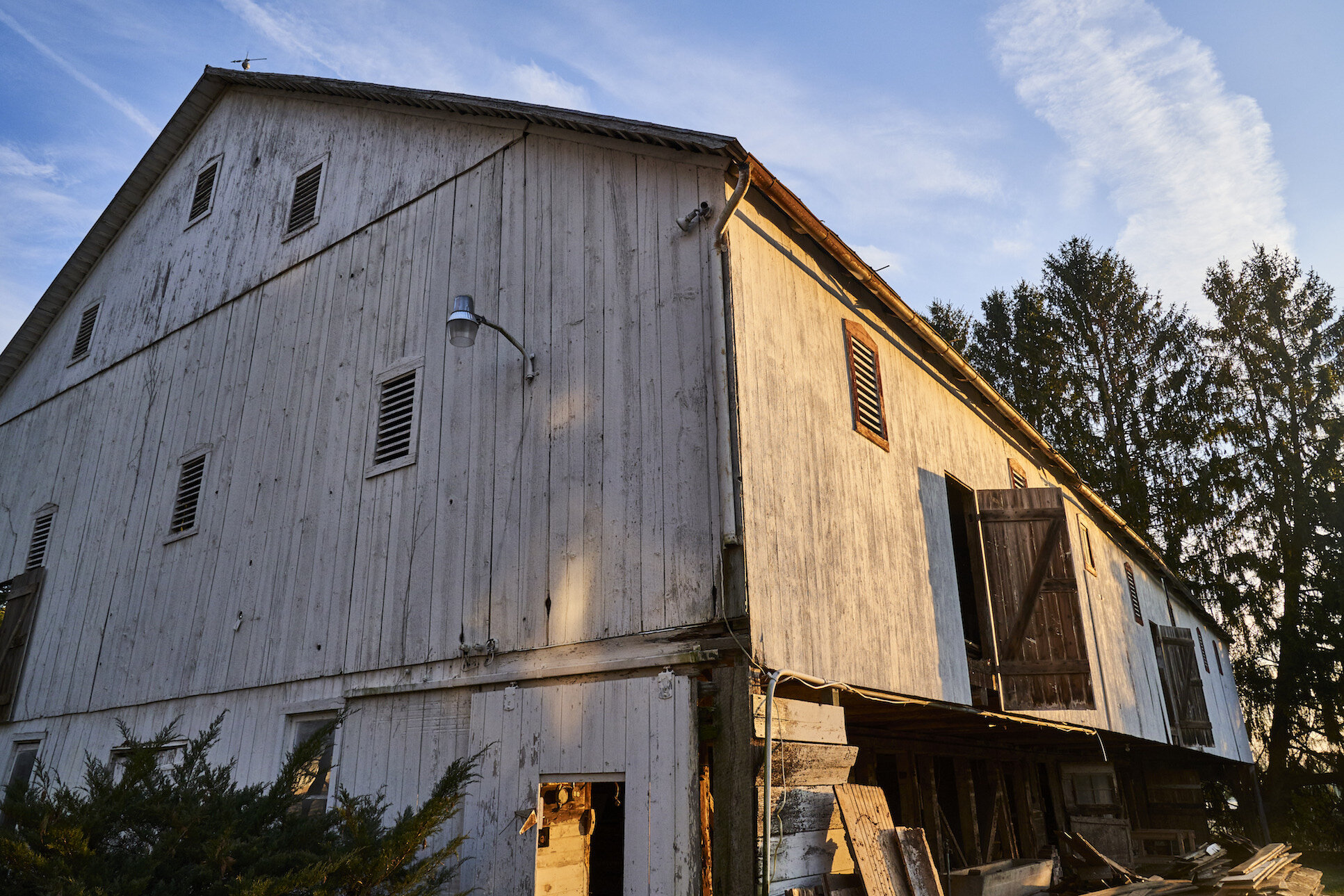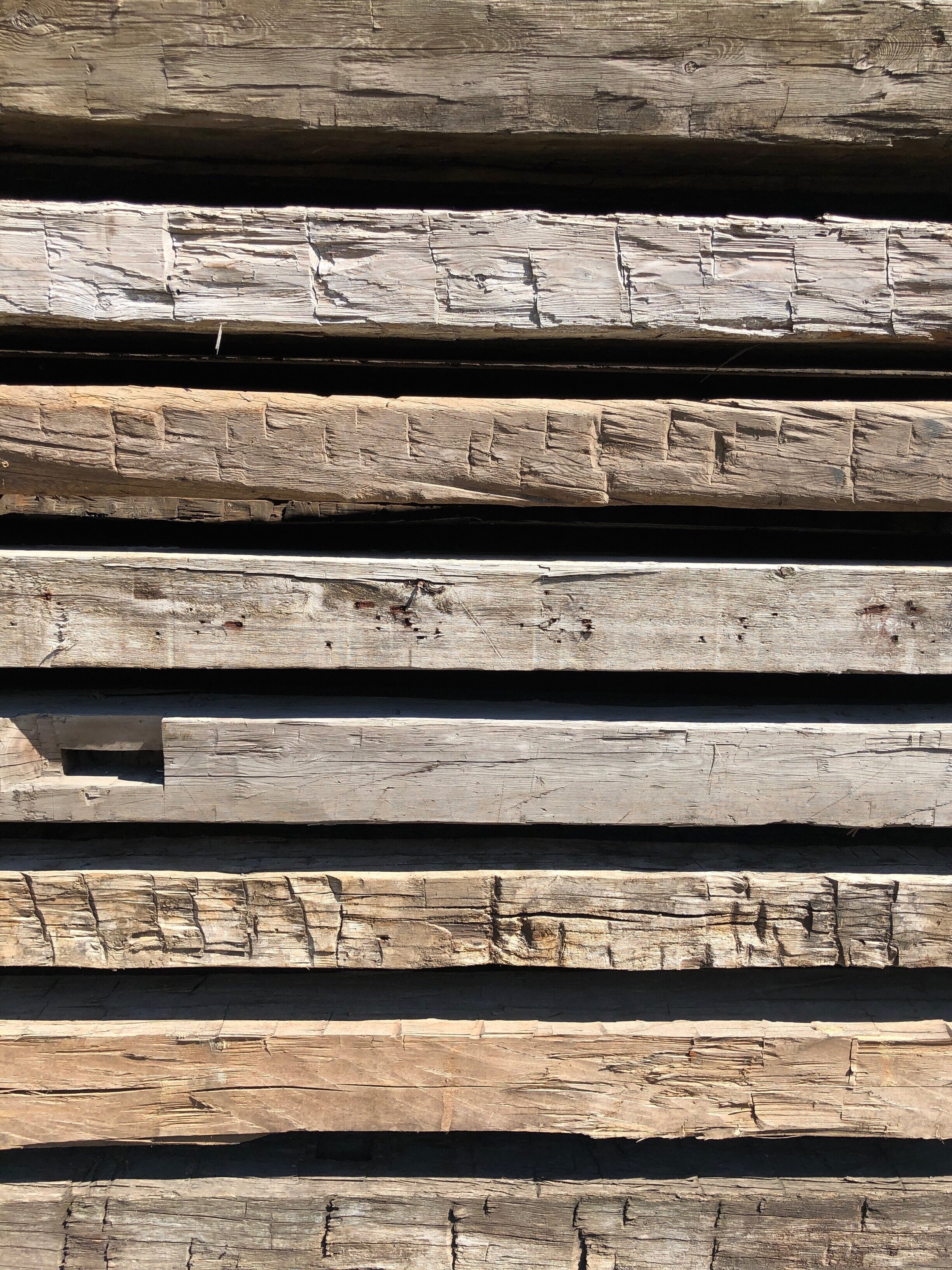Reclaimed wood isn’t just for houses: some of the antique lumber we salvage finds its way to the workshop of Wooden Boatworks in Greenport, Long Island, where it plays a role in making classic wooden boats shipshape. Their team builds, maintains, and restores vintage boats using the traditional tools and techniques of shipwrighting. In this short film, Wooden Boatworks partner and expert sailor Steve Lubitz explains that many of the antique boats they work on come from the “golden age of yachting,” that is, the late 1800’s through the 1940s. For certain restoration projects, the team might need rare wood that’s difficult to find, such as mahogany for a boat’s interior. The Hudson Company can supply the kind of lumber “that doesn’t exist anymore,” says Steve, and can only be sourced through careful salvaging. Boats are heirlooms like any other, and carry as much personal and family history as a home.
Rediscovering Antique Heart Pine in a Historic New England Textile Mill
At The Hudson Company, we reclaim heritage wood sustainably. Often that means salvaging it from beautiful places like this, the Draper Mill building in Hopedale, Massachusetts, where past and present meet. Though it’s quiet today, this mill—spanning over one million square feet—was once a major industrial hub that produced textiles on high-speed power looms. The Draper family built the mill complex in the 19th century using the preferred building materials of the era. One element in particular was exactly what we hoped we’d find when we visited: Antique Heart Pine timber. Milled and finished according to our exacting specifications, this wood will enjoy a second life as the fine flooring, paneling, and beams we are known for. Luckily, we knew just where to find it.
WATCH THE VIDEO ABOVE TO SEE OUR ANTIQUE HEART PINE RECLAMATION.
Protecting your floors this winter
Now that the dry months of Winter are upon us, we’d like to remind all our clients and colleagues that it’s important to care for your wood floors by monitoring the environmental conditions in your home, office, and retail spaces.
The natural expansion and contraction of wood caused by relative humidity levels that are either too high or too low can adversely affect floors, paneling, millwork, and even furniture.
Here are a few easy ways to protect and maintain your floors this season:
Purchase a digital hygrometer
Maintain an interior temperature between 60 - 75 degrees Fahrenheit
Maintain an interior relative humidity of 35 - 55%
For more information, please visit the National Wood Flooring Association’s website, or contact The Hudson Company directly.
Reflecting on THE legacy of artistic problem-solver Wharton Esherick
If you’re familiar with the work of Wharton Esherick (1887–1970), you’re probably imagining the most famous spiral staircase in Pennsylvania right now. Built in 1930 to replace a traditional staircase, it’s tightly curled and elegantly carved from red oak, with a rustic form that appears to defy gravity. Its thick treads seem to float as they spiral around a curvy central column. They’re actually mortised in place and supported by tenons, but the lack of any supporting structure (apart from a mastodon tusk handrail that was added in the late 1940s) gives the staircase an air of magic. It’s just one example from a long career in which Esherick seemed to ask himself what he could do with wood, and never backed away from a surprising answer. Unorthodox solutions and clever workarounds abound in his unique home and studio in Paoli, PA, which is now the site of the Wharton Esherick Museum. And that makes sense, because he never trained as a woodworker; first and foremost he was an artist, and he was able to fashion wonders from any material, never letting the strictures of carpentry fence him in.
The Spiral Staircase in Wharton Esherick's home and studio, 1930.
Photo credit: ©LeslieWilliamson from Handcrafted Modern, Rizzoli, 2010.
Wharton Esherick in his studio with his sculpture Oblivion (dated
1934.) Photo credit: c. 1934 by Emil Luks. Image courtesy of the
Wharton Esherick Museum.
Famous for saying “If it isn’t fun, it isn’t worth doing,” Esherick crafted furniture, made sculpture, designed lighting and interior fittings, and even whole buildings. He’s considered an icon of the Studio Furniture Movement of the mid-20th century, and having lived and worked in Bucks County, he’s also linked to a group of important Pennsylvania makers of his era: George Nakashima, Phillip Lloyd Powell, and Paul Evans. He came from a well-to-do Philadelphia family, and studied printmaking and drawing at the Pennsylvania Museum School of Industrial Art (now known as the University of the Arts), then painting at PAFA, the Pennsylvania Academy of Fine Arts. He was discovering the world of painting just as American Impressionism was flourishing in Philadelphia and Bucks County. Esherick and his wife Letty settled in Paoli after finishing school and bought an historic farmhouse. Here he became interested in carpentry and the sculptural possibilities afforded by wood.
Esherick initially carved woodcuts—a natural outgrowth of his printmaking practice from art school—then he began making abstract sculptures from wood from in the 1920s. In 1926 his work was exhibited at the Whitney Museum of American Art. He then embarked on the long process of designing and building his own home and studio. And by the mid-1930’s, he was creating elaborate interior elements for local clients such as his famous doorway and fireplace for the Curtis Bok House. Considered some of his most important works, the dramatic doorway was meant to evoke the look of draping fabric, while the fireplace, which echoes Art Deco design but veers toward a more extreme, angular style, was inspired by the dramatic shadows cast by a roaring fire.
Fireplace and door by Wharton Esherick from the Curtis Bok House,
1935. Image courtesy of the Wharton Esherick Museum.
“A Pennsylvania Hill House” designed by architect George Howe for
the "America at Home" display at the 1939 World's Fair. Photo by Richard Garrison. Image courtesy of the Wharton Esherick Museum.
Over the next several decades, his work was hard to pin down stylistically. Some works were crisp and geometric like the Bok House architectural elements. Others, like his own staircase and the biomorphic, abstract forms he sculpted, were soft and organic. In 1940, he created a suite of furniture for the exhibition “America at Home” for the 1939-1940 New York World’s Fair. Sixteen architects were invited to design rooms for the exhibition showcasing new American designs, and architect George Howe, who designed Philadelphia’s PSFS building on Market Street, invited Esherick to take part. Howe’s room was called “A Pennsylvania Hill House,” and its design captured the mix of modern and rustic style that was emerging in places like Bucks County in the middle decades of the 20th century. Esherick’s contributions to the exhibition included a sofa from the Bok house, the famous spiral staircase, a five-sided hickory table, and cherrywood wall panels. This exhibition represented the first time that Esherick’s work was seen by a wide-ranging public. Lousie V. Sloane, who was in charge of publicity for the “America at Home” display, wrote in a letter to Esherick that “The ‘Pennsylvania Hill House’ is a very popular room with visitors… and the stairway continues to bring forth exclamations, questions and comments from those who go through the building.”
By his later years, Wharton Esherick was known among colleagues and admirers as the “Dean of American Craftsmen.” His work would eventually earn him a retrospective at the Museum of Contemporary Crafts (now the Museum of Arts and Design) in 1958, and a Gold Medal from the New York Architectural League. His work is included in the collections of the Renwick Gallery of the Smithsonian Institution in Washington, D.C., Metropolitan Museum of Art, The Whitney Museum of American Art, the Philadelphia Museum of Art, the Museum of Fine Arts Boston. One legacy of Esherick’s earliest years working with wood—and a renewable form of accessible art—are his printed holiday cards.
When he was first settling in Paoli and exploring his new surroundings, he made prints that captured the seasons, and his snow-covered scenes of houses and hills were very popular when he made them (and they still are today.) One such print, called “January,” appeared in The Century Magazine, and other prints of his were published in Vanity Fair and The New Republic. “January” depicts a person walking up a road blanketed with snow, with a single blackbird perched on a nearby fence, and four more circling overhead. Using the end grain of a block of wood to create the image, he carved away much of the lower third of the print to leave a pillowy expanse of pristine snowfall. It has an air of mystery, with frost disguising the landscape underneath, and the figure faces away from us. Looking at this image now, it seems quite modern for 1923. And in 2020, there’s something uncannily familiar about it. This holiday season, marked in so many ways by the COVID pandemic, means that many of us have carved out small groups to celebrate with, and some of us will celebrate solo. It feels strange, and it’s not easy. Esherick’s print is not overtly “Christmas-y,” and contains no text, but its single figure with his neighborly birds sends us a timely and powerful message. The only thing to do, especially in the cold and unknown, is to walk straight ahead.
“January”, 1923, wood engraving by Wharton Esherick. Image courtesy
of the Wharton Esherick Museum.
Why We Manufacture
When the COVID-19 pandemic hit the United States in March, a shift from in-person to remote work swept every “non-essential” workplace practically overnight. Suddenly television news anchors were broadcasting from their homes against subdued digital backdrops. Classrooms went virtual, and students became expert “zoomers.” Museums shifted their operations to the web, and began sharing ever more content via Instagram and virtual events and tours. Novice sourdough bread enthusiasts shared their exploits on social media, while others sang the praises of a popular YouTube-based yoga teacher. Writing in the New York Times, reporter Dana Rubenstein noted that many politicians and journalists doing interviews from home were conspicuously displaying The Power Broker, Robert Caro’s massive 1974 biography of Robert Moses on their shelves, along with elegant ceramics and framed photos within view of the camera lens. (There’s even a Twitter feed that documents Power Broker sightings on TV.) It almost started to feel normal.
Of course, digital and virtual economies were vital before the pandemic, too. High school TikTok stars and Instagram influencers have real power (and make real money) these days, not as hobbyists, but as stand-up comics, singer-songwriters, and as arbiters of fashion and style. But as the experiences of brave essential workers demonstrated starkly at the pandemic’s height, digital work is limited to certain fields and certain kinds of jobs. There is no such thing as a digital emergency room doctor or EMT, or a virtual bus driver, or an online-only grocery store stocker. We live in the flesh and blood world, and we can only conduct certain aspects of our daily lives from behind a glowing screen.
Like every other business, when the pandemic began, The Hudson Company had to quickly find workarounds in order to keep functioning safely. We were already doing certain things that made this transition possible: we have a website, social media feeds, we can share digital documents and images instantly, and we can communicate with clients and colleagues using video chat. But when New York State mandated that non-essential businesses close down in March, we had to close our showrooms and our Pine Plains mill. Just like companies that make fabric, tiles or lighting fixtures, there are things that simply cannot be accomplished virtually.
Take reclamation, for example: the expertise and hand skills necessary to deconstruct a barn or farmhouse are years in the making. Each old barn is unique, and our experts need to know what they’re looking at and how to deconstruct it, which is a different task every time. What kind of wood is it? How old is it? What kind of shape is it in? Then the wood comes to our mill. How should it be treated and processed? What features does our client need for a particular project? The tools and techniques required to mill and finish wood, especially to the high standards we’re known for, are not something that can be mastered overnight, nor can they be accomplished alone. Our team has years of expertise, and they work together in real time to produce the flooring and paneling we offer.
New York State has started lifting some of the restrictions for non-essential businesses, but we’re still practicing social distancing, frequent handwashing and mask-wearing, and probably will continue to do so for some time. This may be our new normal. We usually hear the word “manufacture” in the context of industry, and we picture assembly lines, huge factories, and smart machines making things at high speed. But the word “manufacture” itself predates industry, and its Latin root words mean “to make” (facere) “by hand” (manus). Our digital tools, from Instagram to Zoom, have kept us connected these past few months, and we’re grateful for them. Indeed, we probably couldn’t survive without them. But if this experience has taught us anything, it’s that nothing can replace the know-how, creativity, or trained eye of a human being.
The West Village Townhouse
At The Hudson Company we often reclaim wood from centuries-old barns in rural areas that are miles from the nearest town. But occasionally we find antique treasures in buildings that are right around the corner from the entrance to the nearest Manhattan subway station. For a project with architect David Bucovy in Manhattan’s West Village, we actually salvaged, milled and re-installed wood that was found within the structure of the jobsite itself—adaptive reuse at its best.
The house sits along one of Greenwich Village’s most beautifully preserved historic streets, and likely dates from the 1840s, according to Bucovy. Over the years it had been occupied by a cast of New York characters, and though it was originally designed as a single-family home, it was later subdivided into apartments, and even housed a dentist’s office for a time. By the time Bucovy encountered it, the whole building needed structural work, so it was a prime candidate for a gut renovation, which he undertook with Scordio Construction. (The landmarked exterior remained as-is).
Some architects and designers approach renovations like this one with an eye toward preserving or reanimating a 19th century aesthetic, recreating interior details that look the part, or finding period-appropriate lighting fixtures and mirrors to visually root the home in another era. Bucovy and his client took a totally different approach: “We had a desire to make it primal and real, rather than a textbook ‘authentic,’ museum-like renovation.” The client wanted to avoid an all-white kitchen and high-gloss paint, and use old world materials instead. “It’s a house about materiality,” Bucovy says, “the story that hand-wrought plaster tells, or woodgrain.”
The home’s renovated interior doesn’t recall that of a typical West Village row house so much as a château in the South of France, with exposed beams, rustic antiques and kitchen tools, and warm plaster walls throughout. The design team avoided painted gypsum board, and instead used a method called tadelakt, a plastering technique popular in Morocco and other parts of North Africa, in which marble dust and plaster are burnished to make a waterproof wall surface. It can be dyed with umber, and has an earthy, ancient look and feel (and indeed, the technique dates back to ancient Rome).
It turned out that some of the original, 19th century wood used throughout the house—a mix of Hemlock, Pine and Spruce, probably local—was perfect for their needs. We worked with the homeowner and the demolition crew and were able to salvage structural timbers and softwood joists. We brought it up to our mill in Pine Plains and processed it as we usually do: removing old nails, resawing and kiln-drying it, ripping, planing, profiling and end-matching the boards so that they could be reinstalled as ceiling and wall panels. We kept the Original Face, which is weathered through a mix of oxidation, patina, and signs of historic use. Bucovy especially likes Original Face for the way “it records its history and imperfections,” he says.
This aesthetic of exquisite imperfection runs through much of the home’s design and the works of art that the owner installed throughout: wabi-sabi, which is a Japanese concept characterized as the acceptance of imperfection and impermanence. Rooted partly in Buddhist ideals, wabi-sabi celebrates the off-kilter beauty that can be found both in nature and in works of art and design that are asymmetrical, rough, or austere. Bucovy finds inspiration in this concept, and his client happens to be a serious collector of postwar Japanese and Korean art. The aesthetics of these paintings and sculptures happen to dovetail seamlessly with the rustic European look of the interior. Bucovy and the homeowner worked together and sourced both old and new pieces from Belgian art and antiques dealer Axel Vervoort, whose sophisticated farmhouse aesthetic has inspired a renewed enthusiasm for primitive antiques that has thrived despite the lasting dominance of Modernism.
Alongside works of abstract art from Japan and Korea, there are butter-making tools, ceramics, baskets and pieces of furniture dating back to the 1700’s across various parts of Europe. There are Buxy limestone countertops from an extinguished quarry in France. All of these touches complement the wall treatments, hardware and the wood paneling, which has its own story to tell, from 1840’s Greenwich Village, up to the Hudson Valley, and back again in the 21st century.
At Home in Germantown, New York, with Amanda Pays, Corbin Bernsen & Reclaimed Beams from The Hudson Company.
Above: Corbin and Amanda and sons at their new residence (the photo was taken by their oldest son’s girlfriend and became this year’s holiday card).
Actor Corbin Bernsen and his wife Amanda Pays, an interior designer, are seasoned serial renovators. According to a recent article in Remodelista, they’ve lived in 25 houses over their three-decade marriage. (Bernsen even has a film production company called “Star Handyman.”) The couple recently bid farewell to Los Angeles, moved east, and put down roots in the Hudson Valley, where changing seasons and snowfall are giving the family—who were used to sunshine and palm trees—a novel experience that they seem to relish. They bought an 1880s farmhouse in Germantown, NY that needed a gut renovation, but they’ve preserved as many original details as they could, and added in some selective antique touches.
Above: “We went down to the studs and nothing else,” says Corbin of the 1,700 square foot interior. “This is the equivalent of a bionic house.” Explains Amanda: “We replaced or added HVAC, all plumbing, all electric, insulation, new drywall, bathrooms, and the kitchen.”
The couple both come from renovator families: Pays’ father bought and fixed up old properties in southeast England where she grew up, and Bernsen became a skilled carpenter by learning from his uncle and his mother. To give their 1,700 square foot farmhouse a more open floor plan, they removed some walls on the first floor, and installed antique beams to add some rustic beauty to the interior as well as structural support where needed. To find the beams, they turned to their new neighbors, The Hudson Company. The beams they chose are from our collection of Reclaimed Hand Hewn Beams which are salvaged from barns and farmhouses in the Hudson Valley and Canada. Each one is different, but many of them share lovely features: mortise holes, pockets and check marks, which give this farmhouse interior a tactile connection to its architectural heritage. And in Pays and Bernsen’s beautifully restored home, they look like they've always been there.
Above: Corbin’s guitar stands in a corner of the guest room. The reclaimed beams used throughout came from The Hudson Company.
Above: The tub, along with three sinks, came from Hoffman’s Barn in Redhook, NY.
Above: The living space opens to a roomy dining area and kitchen. The cabinets are Ikea—with Ikea’s vertical-grooved Hittarp fronts in an off-white lacquer that Amanda painted herself. “This isn’t something they recommend but it worked well: even the chipping looks authentic. I used a heavy Kilz primer—no sanding—followed by two coats of Benjamin Moore Chelsea Gray in a satin finish.”
Above: The couple—he’s 65, she just turned 60—say they love their new surroundings and plan to stay upstate.
Above: The moody back room with new built-in bookshelves is the library/TV room and Corbin’s home office.
Above: The master bedroom has a conceptual headboard: Amanda dragged the driftwood home from a walk along the Hudson River.
Read the full piece on REMODELISTA.
The pennsylvania barn
This winter, The Hudson Company salvaged lumber from a large 19th century barn in York Springs, PA, a rural farming community in Adams County about 15 miles northeast of Gettysburg. This part of Pennsylvania briefly gained notoriety as a health retreat thanks to the York Sulphur Springs, a summer resort that catered to clientele from Baltimore and Philadelphia, and even hosted George and Martha Washington in 1799. But the construction of the regional railroad shifted traffic away from this part of the state in the 19th century, and it has remained a largely rural enclave ever since. There’s a strong sense of history in this part of the state. Gettysburg was the site of a key battle of the Civil War, and today Gettysburg National Military Park is the most visited battlefield in the United States. Adams County is also the gateway to Pennsylvania Dutch country, and there are nearly 80,000 Amish people—the descendants of Swiss Protestant settlers who eschew modern technology—living in Pennsylvania today. Horse-drawn carriages with bright orange traffic safety signs on the back are a common sight here.
The landscape and architecture of other parts of Pennsylvania—Pittsburgh, Scranton and Philadelphia—were drastically transformed by mining and industry in the 19th and 20th centuries, but this part of the state remains pastoral and green. So it’s no surprise that Pennsylvania is one of the only states in America that has several styles of barn construction named after it. Robert F. Ensminger, an emeritus professor of geography at Kutztown University, developed a typology in his 2003 book The Pennsylvania Barn: Its Origin, Evolution, and Distribution in North America (Johns Hopkins University Press.) Ensminger explains that Pennsylvania’s unique barn architecture is the result of a blending of different European building traditions in collective response to the topography of the region. Immigrants from Germany, Switzerland and the British Isles brought with them the barn construction techniques of their countries of origin, and adapted their designs to suit the landscape they encountered here. He identifies three primary barn types: the Royer-Nicodemus Barn (1790—1900) which were built into hillsides and have overhanging forebays; the Sweitzer or Swisser barn (1730—1850) which are crib-type barns built from logs with overbays and asymmetrical gables; and the Extended Pennsylvania barn, which are taller and wider barns built later in the 19th century with features of the first two types.
The York Springs structure that The Hudson Company recently salvaged was probably an Extended Pennsylvania barn. It has a forebay typical of the Royer-Nicodemus type, which allowed farmers to easily access both the basement and the levels above it. It also has an asymmetrical gable roof like a Sweitzer, so named for the barn Swiss design that likely inspired it. As farming technology improved and productivity increased in the mid-19th century, form followed function, and farmers built larger structures to accommodate livestock, feed, and equipment. The York Springs barn was three stories tall, and had high ceilings on its second level, with many intriguing features. Carved Roman numerals can be found on some of the beams—this may have been a technique for builders to note where each piece of lumber should go in the structure. The floors were built from wide planks. We refer to rustic wood that comes from the area where wheat was likely separated from the chaff as Oak Threshing. As it was deconstructed, the wood beams that supported the upper floor were exposed, revealing a complex, web-like system of interior struts. These are primarily hand-hewn White Oak, and tend to have wonderful characteristics and quirks like mortise holes and pockets. Now all that the wood has been salvaged in York Springs will become the foundational elements of homes and buildings across the United States, extending the life and reach of this centuries-old regional legacy, perhaps for generations to come.
Protecting Your Floors This Winter
Protecting Your Wood Floors
As the dry winter months approach, we’d like to remind all our friends, clients, and partners of the importance of monitoring the environmental conditions in your home, office, and retail spaces.
The natural expansion and contraction of wood caused by insufficient or excessive relative humidity levels can affect your wood floors. This winter, we encourage you to monitor the conditions of your space to maintain a comfortable environment.
Here are a few easy ways to protect and maintain your floors:
Purchase a digital hygrometer.
Maintain an interior temperature between 60 - 75 degrees Fahrenheit.
Maintain an interior relative humidity of 35 - 55%,
For more information, please visit www.nwfa.org or contact The Hudson Company directly.
INSTALLATION IN FOCUS: DOWNTOWN IN COLOR BY HALLIDAY GREER, 8th STREET, MANHATTAN
Interior design by Halliday Greer, Capella, Flat Sawn flooring by The Hudson Company, Photo by Annie Schlechter
Interior and architectural designers Andrew Halliday and David Greer focused on chroma and pattern while thinking about their design for this bright and color bathed residential renovation in lower Manhattan.
Early in the process, the designers and owners were aligned in wanting to use a light colored floor to amplify the brightness of the space without competing with the rest of the colorful elements of the interior. They selected Capella, Flat Sawn White Oak Select Grade flooring for the project. “We wanted something light, neutral and airy so that it didn’t ever feel dark or too heavy…a clean and contemporary envelope that didn’t compete with the deep colors and patterns on the walls,” said Halliday. “We think it looks terrific.”
Photo by Annie Schlechter, Typographic art by Russell Maret
Photo by Annie Schlechter
The entryway paneling is painted a deep teal blue and creates a wonderful arrival that opens up into the rest of the bright apartment. Bold patterned wallpapers were integrated with other graphic elements to create an environment that truly represented the owners themselves. Russell Maret, a type designer and family member, provided some of his typographic artwork, which adorn the walls with color and symmetry.
“Working with The Hudson Company was a terrific and seamless process,” commented Halliday, “we will use their floors many many times in the future.”
Photo by Annie Schlechter




